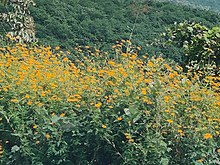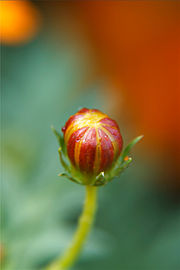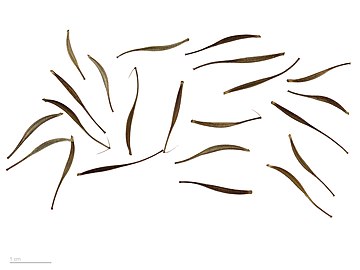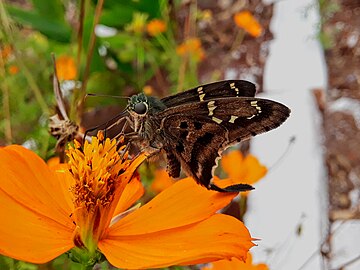| Cosmos sulphureus | |
|---|---|

| |
| Scientific classification | |
| Kingdom: | Plantae |
| Clade: | Tracheophytes |
| Clade: | Angiosperms |
| Clade: | Eudicots |
| Clade: | Asterids |
| Order: | Asterales |
| Family: | Asteraceae |
| Genus: | Cosmos |
| Species: | C. sulphureus |
| Binomial name | |
| Cosmos sulphureus Cav. | |
| Synonyms | |
| |

Cosmos sulphureus is a species of flowering plant in the sunflower family Asteraceae, also known as sulfur cosmos and yellow cosmos. It is native to Mexico, Central America, and northern South America, and naturalized in other parts of North and South America as well as in Europe, Asia, and Australia.
This plant was declared invasive by the United States Southeast Exotic Pest Plant Council in 1996. The flowers of all Cosmos attract birds and butterflies, including the monarch butterfly.
Description
This species of Cosmos is considered a half-hardy annual, although plants may re-appear via self-sowing for several years. Its foliage is opposite and pinnately divided. The plant height varies from 1–7 feet (30–210 cm). The original and its cultivars appear in shades of yellow, orange, and red. It is especially popular in Korea and Japan, where it is often seen in mass plantings along roadsides, following an initiative pursued by the Korean-Japanese botanist Woo Jang-choon.
Cultivars
Cultivars include:
- 'Brightness Red' agm
- 'Klondyke Mix', 'Polidor' consists of a variety of colors in shades from yellow to orange and scarlet
- 'Ladybird Dwarf Red', 'Ladybird Dwarf Gold', 'Ladybird Dwarf Orange', and 'Ladybird Dwarf Lemon' are shorter than the species at 40 cm. Their flowering is very early. The flowers have vibrant colors in hues of yellow, orange and scarlet. Another cultivar is named 'Bright Eyes'.
- 'The Diablo' reaches 75 cm with flowers of 5 cm intense orange red.
- 'The Polidor' reaches 75 cm and bears semi-double flowers in shades of golden yellow, orange and red.
- 'The Sunny Red' and 'Sunny Gold' have single flowers on stocky plants at 35 cm.
- 'The Sunset' reaches 90 cm. It bears double or semi-double flowers in shades of red or scarlet orange
- 'Tango' agm
(those marked agm have gained the Royal Horticultural Society's Award of Garden Merit).
Cultivation

Growth characteristics of this plant include:
- Germination takes between 7 and 21 days at the optimal temperature of 75 degrees Fahrenheit; flowering begins between 50 and 60 days after germination
- It prefers a soil pH between 6.0 and 8.5, reflecting its native habitat in the alkaline regions of Central America
- Flowering is best in full sun, although partial shade is tolerated
- The plant is tolerant to drought after germination, and is seldom subject to insect or disease damage; this vigor is attested by its status as a pest in some areas of the United States
Use
- Young shoots are eaten raw or cooked in Indonesia under the name of lalab or gudang.
- The flowers are a dye, producing an orange-yellow dye, used in pre-Columbian America and later in southern Africa to dye wool.
- In Thailand, they are consumed in salads or herbal tea with the effect of inhibiting pancreatic lipase.
- According to a Pakistani team (2017), in rats subjected to a high dose of paracetamol, extract of the plant has a hepatoprotective effect.
- A Ukrainian publication (2017) attributes to a bread containing 10% dry extract of Cosmos sulphureus a good note for its organoleptic qualities.
Gallery
-
 Cosmos sulphureus in orange flower
Cosmos sulphureus in orange flower
-
 Cosmos sulphureus with bee
Cosmos sulphureus with bee
-
 Bud of Cosmos sulphureus
Bud of Cosmos sulphureus
-
 Cosmos sulphureus in Kerala
Cosmos sulphureus in Kerala
-
 Sulfur cosmos flower
Sulfur cosmos flower
-
 Cosmos sulphureus, buds, flower and leaves
Cosmos sulphureus, buds, flower and leaves
-
 Cosmos sulphureus - MHNT
Cosmos sulphureus - MHNT
-
 Cosmos sulphureus
Cosmos sulphureus
-
 Cosmos flower on bokeh mode
Cosmos flower on bokeh mode
-

-

References
- Flann, C (ed) 2009+ Global Compositae Checklist Archived 2014-11-15 at archive.today
- Flora of North America, Vol. 21 Page 205 Cosmos sulphureus Cavanilles, Icon. 1: 56, plate 79. 1791.
- Flora of China Vol. 20-21 Page 857 硫磺菊 liu huang ju Cosmos sulphureus Cavanilles, Icon. 1: 56. 1791.
- Jørgensen, P. M., M. H. Nee & S. G. Beck. (eds.) 2014. Catálogo de las plantas vasculares de Bolivia, Monographs in systematic botany from the Missouri Botanical Garden (1–2): i–viii, 1–1744.
- Nash, D. L. 1976. Tribe V, Heliantheae. En: Nash, D.L. & Williams, L.O. (Eds), Flora of Guatemal a - Part XII. Fieldiana, Botany 24(12): 181–361, 503–570
- Dodson, C.H., A.H. Gentry & F.M. Valverde Badillo. 1985. La Flora de Jauneche: Los Ríos, Ecuador 1–512. Banco Central del Ecuador, Quito
- Strother, J. L. 1999. Compositae–Heliantheae s. l. 5: 1–232. In D.E. Breedlove (ed.) Flora of Chiapas. California Academy of Sciences, San Francisco
- Hokche, O., P. E. Berry & O. Huber. (eds.) 2008. Nuevo Catálogo de la Flora Vascular de Venezuela 1–859. Fundación Instituto Botánico de Venezuela, Caracas
- US Department of Agriculture Plant Profile of Cosmos sulphureus
- ""Cosmos sulphureus" 'Brightness Red'". RHS. Retrieved 5 May 2020.
- ""Cosmos sulphureus" 'Tango'". RHS. Retrieved 5 May 2020.
- Plant Answers, Texas A&M University, Cosmos history and cultivation
- TK Lim , Edible Medicinal and Non-Medicinal Plants: Volume 7, Flowers , Springer Science & Business Media,November 8, 2013 (ISBN 9789400773950)
- D. Buti , D. Domenici , C. Grazia and J. Ostapkowicz , " Further Insight into Mesoamerican Paint Technology: Unveiling the Color Palette of the Pre-Columbian Codex Fejérváry-Mayer by Means of Non-Invasive Analysis ", Archaeometry, March 6, 2018 (ISSN 1475-4754)
- Mohammad Saleem et al., " Chemical characterization and hepatoprotective potential of Cosmos sulphureus Cav. and Cosmos bipinnatus Cav. " , Journal Natural Product Research / Formerly Natural Product Letters ,December 2017
- Nina Osokina , Kateryna Kostetska , Helena Gerasymchuk and Valeriia Voziian , " DEVELOPING OF RECIPES AND ESTIMATION OF RAW MATERIAL FOR PRODUCTION OF WHEAT BREAD " , EUREKA: Life Sciences , vol. 0, n o 4,July 31, 2017, p. 26-34
External links
- Jepson Manual Treatment
- Calphotos Photo gallery – University of California
- Details – Royal Horticultural Society
| Taxon identifiers | |
|---|---|
| Cosmos sulphureus |
|